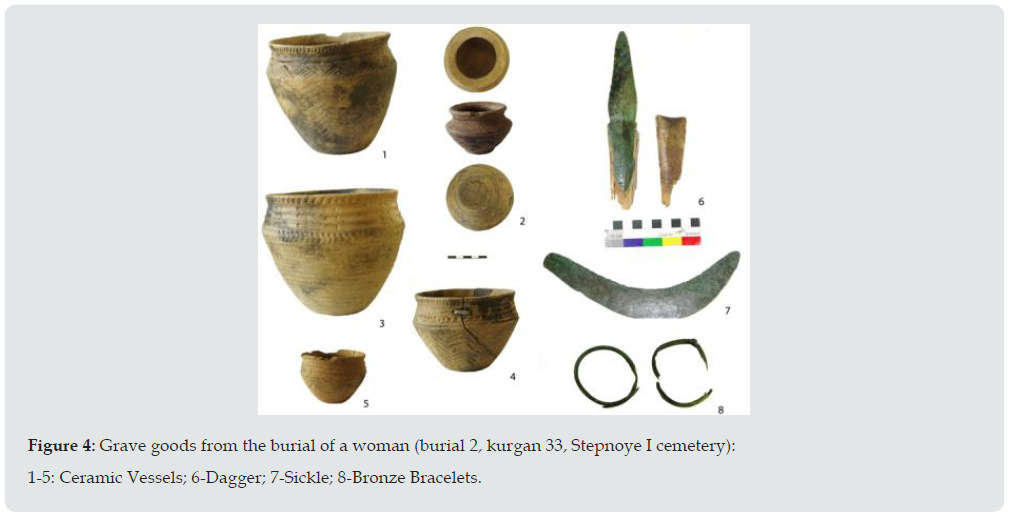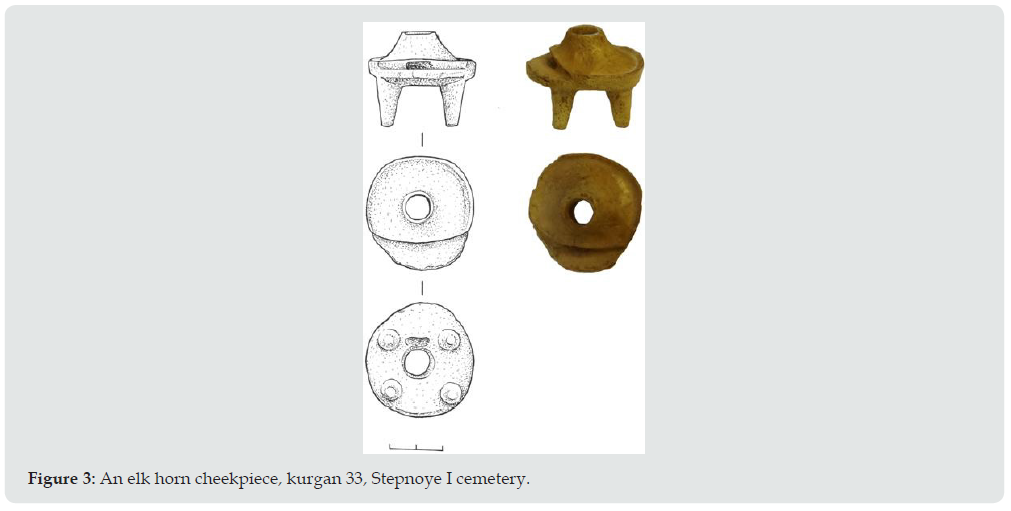
Lupine Publishers Group
Lupine Publishers
Menu
ISSN: 2690-5752
Mini Review(ISSN: 2690-5752) 
New Evidence of Charioteering Among Bronze Age Tribes in the Southern Trans-Urals (Russia) Volume 6 - Issue 5
Elena Kupriyanova*
- Scientific and Educational Center of Study of the Problem of Nature and Man, Chelyabinsk State University, Russia
Received:April 15, 2022; Published: April 22, 2022
Corresponding author: Elena Kupriyanova, Scientific and educational center of study of the problem of Nature and Man, Chelyabinsk state university, 454001 Br. Kashyrinykh st, 129, Chelyabinsk, Russia
DOI: 10.32474/JAAS.2022.06.000248
Abstract
In 2021 field season, we have received a new data of chariot culture of the Bronze Age in Southern Trans-Urals. The burial of man with traces of combat trauma, cheek-piece and horses sacrifices has a central position in the big kurgan of Sintashta archaeological culture.
Keywords: Bronze Age; Southern Trans-Urals; Chariots; Burial
Introduction
The sites of the Sintashta and Petrovka archaeological cultures of the Bronze Age of the Southern Trans-Urals (Russia) have been traditionally considered as part of the realm of chariot cultures of early Indo-European tribes. Since the beginning of the 2000s, near the modern village of Stepnoye in the Chelyabinsk region (Figure 1), archaeologists of Chelyabinsk State University have been conducting research on a fortified settlement (with the participation of colleagues from the USA and Great Britain) and cemeteries of the Middle and Late Bronze Age. There, the researchers have found vivid evidence of the development of metallurgical production, cattle breeding, and military arts [1,2].
Numerous finds of chariot fragments, elk horn cheekpieces, paired horse sacrifices, remote combat weapons in cemeteries of Stepnoye I and Stepnoye VII have been repeatedly subjected to scientific analysis [3]. The study of the finds proves that the phenomenon of charioteering had a great symbolic role in the paradigm of the steppe tribes of the Bronze Age. Collective burials have been recorded, in which even women and children are accompanied by weapons, cheekpieces, fragments of chariots and sacrificial horses. Based on this, we have concluded that the community of “charioteers” included members of a certain clan, possibly related to the production and use of chariots, horse training, etc. At the same time, however, there have been recorded some individual burials of adult men with elements of a chariot complex which occupied central positions of kurgans. Those men could be real chariot warriors. Recent findings provide a vivid confirmation of this.
In the field season of 2021, under the guidance of the author of the article, the Sintashta burial complex (kurgan 33) was investigated in the Stepnoye I cemetery, in the central burial of which there was a skeleton of a 35-50-year-old man who had a round hole on his skull, healed during his lifetime. Theoretically, such an injury could have been caused by a battle axe, similar to the ones found at the sites of the Sintashta and Petrovka cultures (Figure 2). In addition, there were abnormal osteophytosis growths on all areas of the man’s spine, which could have resulted from both injury and high spinal strain caused by driving a chariot.
Figure 1: Map of sites near the village of Stepnoye: 1-fortified settlement Stepnoye 2-Stepnoye I cemetery 3-Stepnoye VII cemetery 4-Stepnoye 25 cemetery

Figure 2: The skull of a charioteer warrior with traces of combat injury. 2- A bronze axe from burial 17 of the Stepnoye VII cemetery

The burial was robbed in ancient times. One elk horn cheekpiece (an element of horse harness) was found in it (Figure 3), along with bone fragments of individual animals- 6 horses, 7 cattle, 6 small cattle, and one dog. Interestingly, the dog also had spinal injury healed during lifetime.
Around the central male burial, there were 15 burials of infants, almost every one of which contained sacrifices with fragments of several sheep and goats, and vessels for funeral food. On the periphery, there was also one burial of a 25-35-year-old woman with rich sacrifices of 6 individuals of large and small cattle, and numerous grave goods (bronze bracelets, sickle, dagger, ceramic vessels, etc.) (Figure 4). All the details of the burial rite indicate that the buried man was a significant person for the collective, probably a charioteer warrior. The previously obtained AMS dates allow us to date the Sintashta complexes of the Stepnoye I cemetery to the range of about 1950-1850 BC. Thus, the newly investigated kurgan 33 of the Stepnoye I cemetery is another piece of evidence indicating the existence of chariot culture among the steppe tribes of the Bronze Age in the Southern Trans-Urals.
Figure 4: Grave goods from the burial of a woman (burial 2, kurgan 33, Stepnoye I cemetery): 1-5: Ceramic Vessels; 6-Dagger; 7-Sickle; 8-Bronze Bracelets.

Acknowledgements
The author expresses gratitude to Dr. Alina Chirkova (Center of Paleo-ethnological research) for anthropological definitions, Dr. Aleksei Rassadnikov (Ural department of Russian Academy of Science) for definitions of animal remains, Dr. Andrey Epimakhov (Ural department of Russian Academy of Science), Dr. Peter Hommel (Liverpool University) and Dr. Bryan Hanks (Pittsburg University) for joint work on AMS dating.
References
- Hanks B, Doonan R, Zdanovich D, Kupriyanova E, Pitman D, et al. (2014) Metals, Society and Economy in the Late Prehistoric Eurasian Steppe. Archaeometallurgy in Global Perspective. Early metallurgy: a global reader. New York, USA Springer pp. 755-784.
- Pitman D, Doonan R, Hanks B, Zdanovich D, Kupriyanova E, et al. (2013) Exploring metallurgy in Stepnoye: the role of ceramic in the matte conversion process // Historical metallurgy society. Accidental and Experimental Metallurgy 7(1): 153-160.
- Kupriyanova E, Epimakhov A, Berseneva N, Bersenev A (2017) Bronze Age Charioteers of the Eurasian Steppe: A Part-time Occupation for Select Men? Praehistorische Zeitschrift 92(1): 40-65.

Top Editors
-

Mark E Smith
Bio chemistry
University of Texas Medical Branch, USA -

Lawrence A Presley
Department of Criminal Justice
Liberty University, USA -

Thomas W Miller
Department of Psychiatry
University of Kentucky, USA -

Gjumrakch Aliev
Department of Medicine
Gally International Biomedical Research & Consulting LLC, USA -

Christopher Bryant
Department of Urbanisation and Agricultural
Montreal university, USA -

Robert William Frare
Oral & Maxillofacial Pathology
New York University, USA -

Rudolph Modesto Navari
Gastroenterology and Hepatology
University of Alabama, UK -

Andrew Hague
Department of Medicine
Universities of Bradford, UK -

George Gregory Buttigieg
Maltese College of Obstetrics and Gynaecology, Europe -

Chen-Hsiung Yeh
Oncology
Circulogene Theranostics, England -
.png)
Emilio Bucio-Carrillo
Radiation Chemistry
National University of Mexico, USA -
.jpg)
Casey J Grenier
Analytical Chemistry
Wentworth Institute of Technology, USA -
Hany Atalah
Minimally Invasive Surgery
Mercer University school of Medicine, USA -

Abu-Hussein Muhamad
Pediatric Dentistry
University of Athens , Greece

The annual scholar awards from Lupine Publishers honor a selected number Read More...





